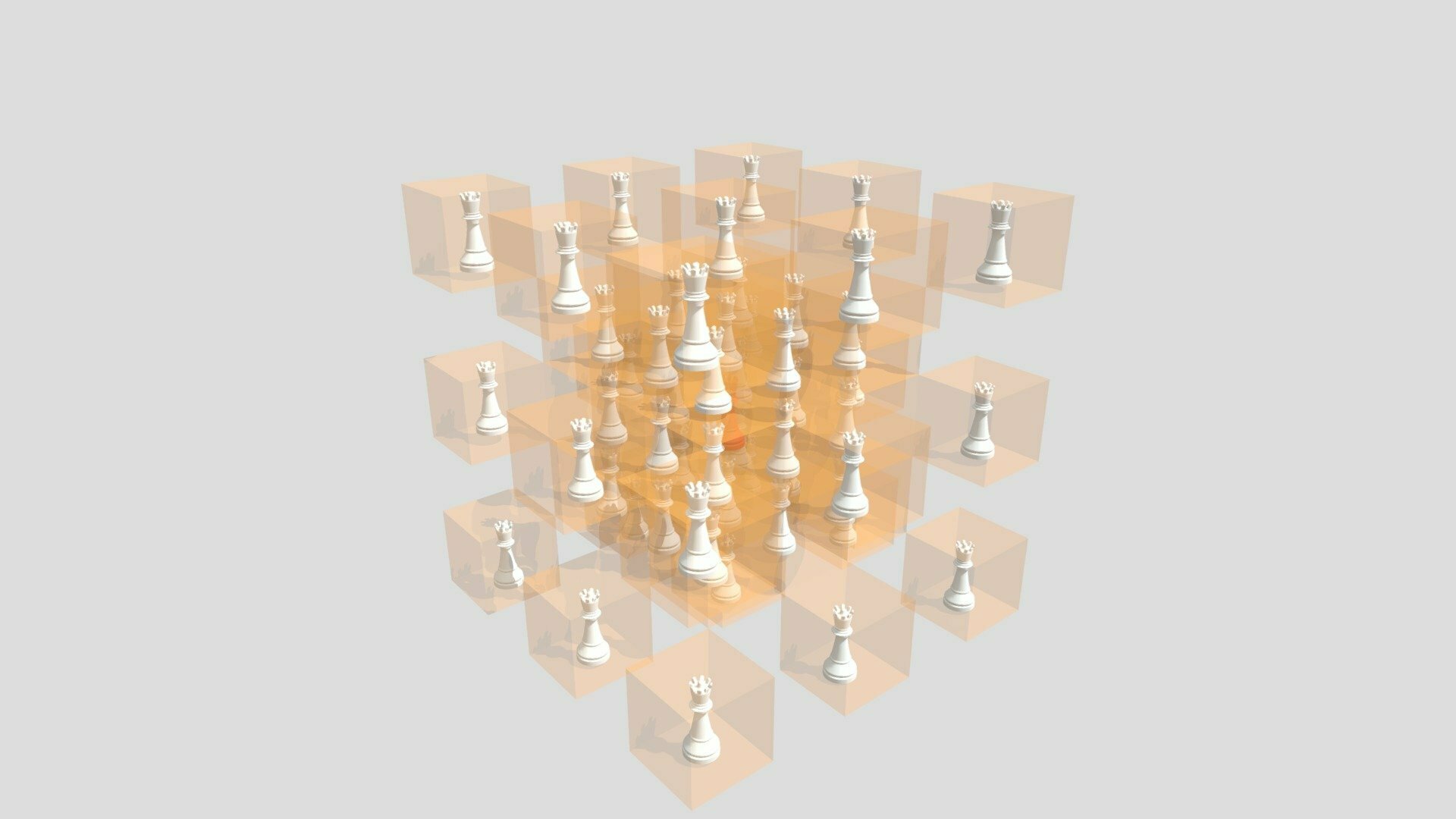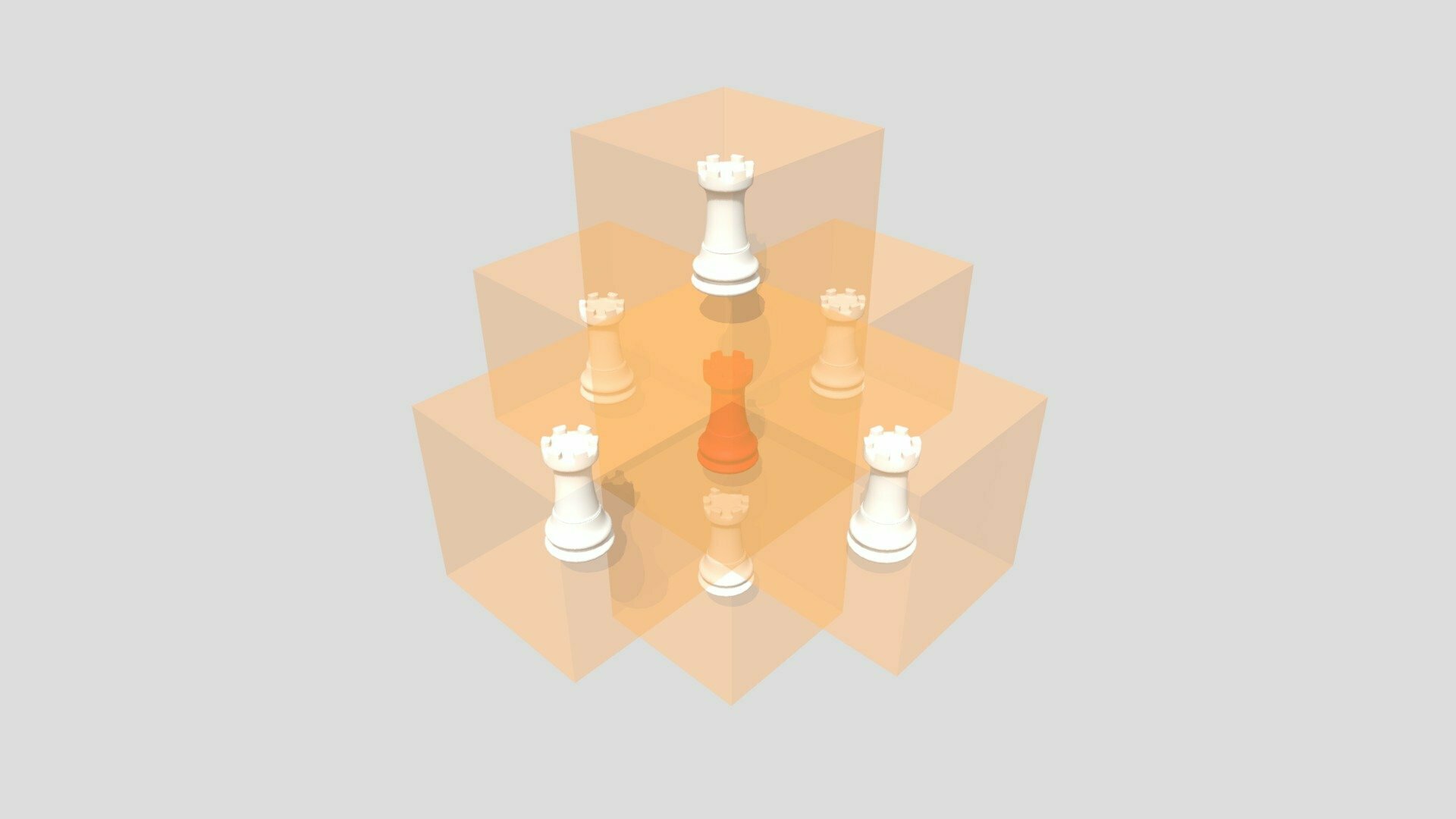Computational complexity of some domination problems on polycubes
Alexis Langlois-Rémillard
ScaDS.AI Leipzig
Presented 2023-06-16, Kyoto
Joint work with Mia Müßig and Érika Roldán-Roa
A small history of domination
The concept of domination, and more generally of graph theory, started in recreation and military problems.
It has been studied by some of the greatest mathematicians and is a lively and hard topic.
We will go over some of these motivating problems
- Constantine the Great (274–337) defense scheme
- Puzzles brainteasers
- Chess problems
A small history of domination
Constantine problem:
How to minimise the legions needed to protect the cities in the Roman empire?
His solution:
Place at most 2 legions in cities such that all cities are neighbouring one legion.
Graph: (Roman domination Cockayne, Dreyer Sr., S.M. Hedetniemi, S.T. Hedetniemi, (2004) Discret. Math. 278)
Colour the graph's verticies with 0,1,2 and make sure all vertices of colour 0 are neighbour of at least one with colour 2.
A small history of domination
Euler (1706–1783)
- bridges of Königsberg;
- knight tour;
- Euler's characteristic: \(V-E+F=2\).
A small history of domination
8 queens problem
Place 8 queens on the chessboard so that they cannot threaten each others. How many solutions are there?
- Max Bezzel introduced it 1848
- Gauss and Schumacher discussed it 1850
- Nauck published the 92 solutions in 1850
- known up to \(n=27\) (2016).
A small history of domination
5 queens problem
Place 5 queens on the chessboard to threaten all squares.
- De Jaenisch introduced it after a letter in 1863
- Sparked a lot of interest
- known up to \(n=32\). (2022)
- unknown if the number of queens needed always increases (!)
Conjecture (Hedetiemi ~1992)
The domination number grows monotonously with \(n\).
Chess to graph theory
Primer on graph theory
Graph: \( (V,E) \), set of vertices \(V\) and set of edges \(E\).
Bipartite: The vertices divide in two sets with edges only between the two sets.
Planar: the graph can be placed with edges that do not cross.
Example:
Chess to graph theory
Primer on graph theory Graph \(G=(V,E)\)
Clique: A subset of vertices all connected to each others
Coclique: A subset of vertices with no edge between them
Domination: find a subset of vertices to which all vertices are attached.
Example:
Chess to graph theory
Chess graph
Choose a piece. The vertices are the square of the chessboard, and there is an edge between two vertices if the piece can travel between the two.
Example:
Chess to graph theory
Converting problems into graph
- Domination
- n-queens problem
- Queen domination
- Find a domination set
- Find a maximal coclique
- Find a minimal coclique
We will study those problems for queen and rook graphs on slightly different chessboards.
Chess to graph theory
Some notation
MinDom(I)R: minimal (independent) domination on rook graph.
MinDom(I)Q: minimal (independent) domination on queen graph.
MaxR: maximal coclique on rook graph.
MaxQ: maximal coclique on queen graphs.
Chess to graph theory
Some results on chessboard of size \(n \)
MinDom(I)R: trivial (\(n\) rooks);
MinDom(I)Q: unknown;
MaxR: trivial (\(n\) rooks);
MaxQ: easy (\(n\) queens after \(n\geq 4\), an explicit solution for each \(n\) was given by Emil Pauls in 1873)
Polycubes
Polyomino
1) A polyomino is a connected set of edge-connected tiles.
2) A rook moving on an infinite chessboard defines a polyomino.
Polycubes
The generalisation to dimension \(d\).
1) a set of face-connected hypercubes.
Example:
Polycubes
Queen and rook movement
A rook moves through faces. A queen moves through all intersections (in 3D: faces, edges and vertices).
Example: link rook link queen
Polycubes
Domination on polycubes
Define the graph on polycubes. Only concern: you cannot jump.

Polycubes
Problems
We will study the MinDomR/Q and MaxR/Q problems on polycubes.
One change:
We cannot say how many will be necessary knowing only the number of tiles of the polycube

Polycubes
Proposition (Alpert–Roldán-Roa)
- Given a polycube of size \(n\geq 2\), the minimal number of rooks needed lies between 1 and \(\lfloor \frac{n}{2}\rfloor\).
- Given a polycube of size \(n\geq 3\), the minimal number of queens needed lies between 1 and \(\lfloor \frac{n}{3}\rfloor\).

Polycubes
Proposition (Alpert–Roldán-Roa)
- Given a polycube of size \(n\geq 2\), the minimal rook domination number lies between 1 and \(\lfloor \frac{n}{2}\rfloor\).
- Given a polycube of size \(n\geq 3\), the minimal queen domination number lies between 1 and \(\lfloor \frac{n}{3}\rfloor\).
Proof 1:
Polycubes
Proposition (Alpert–Roldán-Roa)
- Given a polycube of size \(n\geq 2\), the minimal rook domination number lies between 1 and \(\lfloor \frac{n}{2}\rfloor\).
- Given a polycube of size \(n\geq 3\), the minimal queen domination number lies between 1 and \(\lfloor \frac{n}{3}\rfloor\).
Proof 2:

COmputational complexity
We will quantify how hard the problem is instead.
P
There is a polynomial algorithm.
NP-Complete
- We can verify a solution in polynomial time.
- It is equivalent to SAT
- As difficult as any other NP-complete problem.
- No known polynomial algorithm exists.
COmputational complexity
Proposition (A–RR 2021 and LR–M–RR 2022)
MinDomR and MinDomQ are NP-complete.
So it's hard. Let's test how!
COmputational complexity
Proposition (A-RR 2021)
MaxR is in P on polyominoes
Proof:
COmputational complexity
Question (A-RR 2021)
What is the complexity of MaxR/Q on polycubes of dimension \(d\geq 3\)?
Our results
Proposition (LR-M-RR 2022)
MaxR and MaxQ are NP-complete on polycubes of size \(d\geq 3\).
Proof:
- Prove that verifying a solution is polynomial
- Reduce the problem to a known NP-complete problem in polynomial time.
Our results
Proposition (LR-M-RR 2022)
MaxR/Q are NP-complete on polycubes of size \(d\geq 3\).
Proof:
- Prove that verifying a solution is polynomial
Easy. Given a proposed placement, we check that everything is covered and it grows only polynomially with the size of the board.
Our results
Proposition (LR-M-RR 2022)
MaxR and MaxQ are NP-complete on polycubes of size \(d\geq 3\).
Proof:
2) Reduce to a known NP-complete problem
This is harder. We go for P3SAT3
Our results
P3SAT3
- Set of Boolean variable
- Set of clauses with 2 or 3 literals
- Bipartite clause graph is planar
- Bipartite clause graph has exactly three edges per literals
Our results
We will go from an instance of P3SAT3 to a rook domination problem on polycubes.
We need:
- Literal gadgets
- Splitting gadget
- Clause evalutation gadgets
Literal gadgets

Splitting gadgets

Clause gadgets
\(x_1\vee x_2\) or \(\bar x_1\vee \bar x_2\)

Clause gadgets

Clause gadgets

Clause gadgets

Putting clauses

Translation
1. \(X\) an instance of P3SAT3
2. Construct polycube \(P(X)\)
3. From the gadgets, we know its guarding number \(N\) will respect:
4. The instance is true if and only \( N= M + x_{Clause}\). (All clauses are true.)
Translation
Sanity check: is the polycube too big?

Algorithm
Algorithm
We encoded this as an Integer Linear Programming instance and used the methods of Huangfu and Hall 2018, Math. Program. Comp. to obtain an efficient solver.
Continuation
A word on queens
- Claim: MaxQ is NP-complete for polycubes \(d\geq 2\).
- Certain proof: MaxQ is NP-complete for polycubes \(d\geq 3\).
Convex Polyominoes
- Conjecture MinDom(I)Q/R are NP-complete over convex polyominoes
- Corollary MaxR is in P for convex polyominoes
- Conjecture MaxQ is NP-complete over convex polyominoes
Thank you!
Computational Complexity of domination problem
By aliocha
Computational Complexity of domination problem
- 315




